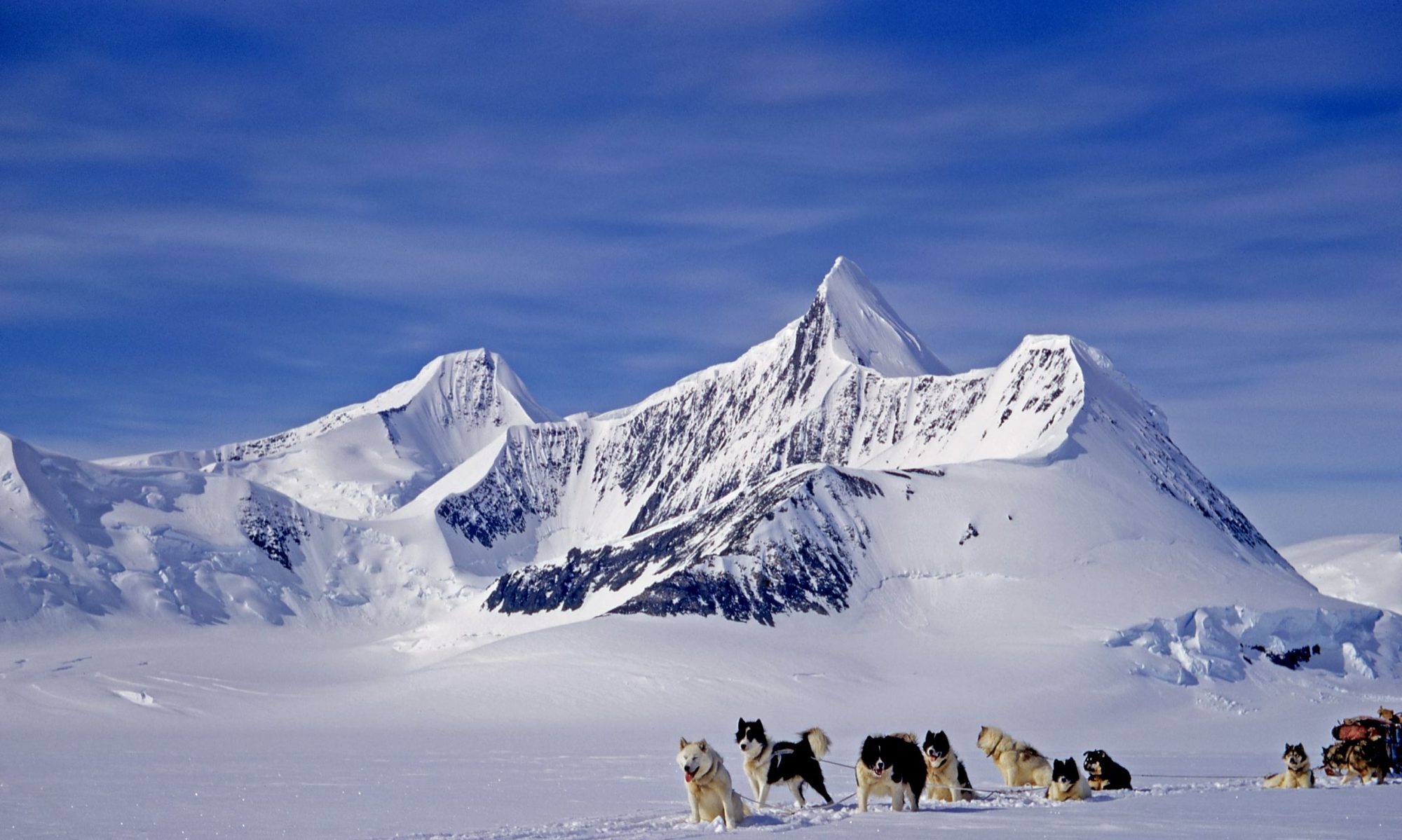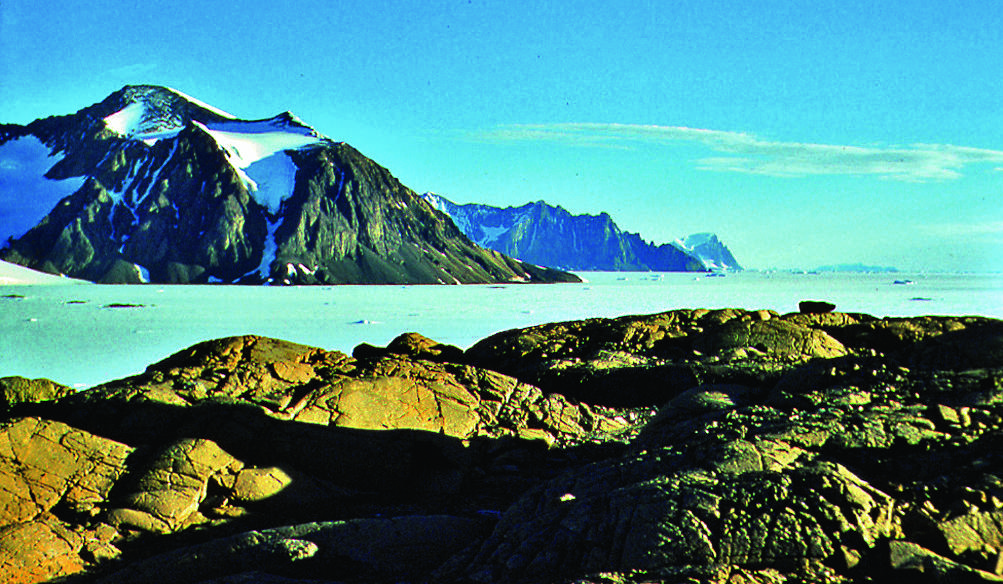Header Photo: View south from near Base Y – the first spur is the southern arm of Horseshoe I, then Camp Point (part of the mainland) followed by Millerand Island, just West of Stonington (Photo: Robin Perry)
August – Horseshoe to Stonington (continued)
The Argies took spells of one hour each trail-breaking, and by sunset we were three-quarters of the way across Calmette Bay. Teniente Giró asked me if I preferred to continue in the dark in a similar manner—we had another eight miles or so to go—or camp. As we only had to follow and there were no difficulties, it suited us very well to press on with the prospect of a reception at San Martín base instead of the camping routine. After the long twilight had finally faded there seemed to be longer delays, and I had continually to stop my team which, although still willing, was showing signs of exhaustion. About 200 yards short of the base there was a long delay as the Argies’ sledges were sorted out and the other base members apprised of our arrival, and by the time we had picketed and unharnessed it was after 23.00. Then we were led to our sleeping quarters. Sergeants Rodriguez and Pérez shifted their mattresses to the floor near the stove in the centre of the room so that we could have their bunks. The stove burned a very soft sort of coal, almost peat, leaving much ash, and requiring frequent replenishment. Next we were taken to the other part of the base where sleep four of the seven and where all meals are taken. Here we were served beefsteak and tomato with soup and wine at about midnight.
Returning to our dormitory we partook of maté. Francisco Pérez prepared it—he comes from Comodoro Rivadavia and is a very chatty friendly chap with a few words of English. I found the maté very enjoyable. We all turned in at 02.15 and slept soundly.
Tuesday 25 August – Rose at noon and proceeded to the dining site, but on the way I saw that my team had pulled out their pickets and were lying around the sledge. The battle that must have ensued did not seem to have left much in the way of scars on the dogs, but the trace was most infernally knotted up. Snow and a breeze with the temperature around –4°C was making deep drifts. Lunch was a mere snack: cold meat, then steak, soup, wine and tea.
We spent the afternoon sitting in the dining place talking and reading Argentinian magazines and listening to their record player. I went out at 17.30 to feed the dogs in much snow and wind. It was Francisco Pérez’s birthday, and at 20.00 we sat down in front of a mass of plates containing various savouries and glasses of Cinzano. We were each provided with a fork to spear a desired delicacy. After that the meal started in earnest. The main course was chicken, then soup, fruit salad and wines to go with them. Then the cake was brought in: a gargantuan affair with frosting and icing made, we were told, from butter, sugar and gin. Naturally that called for Argentinian champagne. To round all this off we had tea.

(Photo: Robin Perry)
Dr Carlos Ramasciotti from Cordoba, the only civilian on the base, was extremely knowledgable on almost everything, and of course spoke excellent English. He produced a road map which I for one found a lot more interesting than the magazines. Teniente Giró also came from Cordoba, Sergeant Miguel Verón from Formosa in the far north (and he looked the part—the only ‘indian’), Raul Rodriguez from Resistencia, Corporal Oscar Alfonso was from Santo Fé, and Corporal Rogelio Monzón presumably hailed from BA. We left table at 23.45 and made for our sleeping quarters for the maté session and a guitar/song recital by Francicso. Heads were down by 02.15.
Wednesday 26 August – All this time the weather had been bad. When we got up at noon it was still snowing and blowing, but much colder: –21°C. The same light lunch menu as yesterday, then quickly back to the stove for an afternoon maté session. Then, as the wind eased, we ventured out. I was shown the met instruments and saw something of the island (one of the Debenhams), and also fed the dogs. Keith’s sledge was partially buried, mine OK, but dogs had chewed a few items, including my spare gloves and a whirling psychrometer! Francisco was very excited at the prospect of a trip to Mushroom Island (and hopefully beyond) in the near future. He also wanted to come with Raul to visit us at Horseshoe in early November. Dinner was an entrée of crawfish, then beefsteak à l’estancia, soup, birthday cake, etc. This evening we were in bed by midnight.
Thursday 27 August – Keith and I had considered going on to Stonington in the afternoon, but it was still very cold and also we intended trying to QSO Base Y in the evening. Therefore Keith is doing his local geology now instead of on our way back. After darning socks I visited most of the Debenhams, which seemed a charming group of islets; the Northeast Glacier had overwhelmed some of the easternmost. Adelaide Island was just visible with its impressive Mount Gaudry. Teniente was opening boxes of meteorological instruments brought from Henkes Islands (south of Adelaide), and I went to get our sledge barometer as a means of calibrating their new ones. Their barograph is daily, other graphs weekly, and all made in Argentina. Keith came in at 16.15. After dinner I went with Francisco to the radio
cabin and we successfully contacted Base Y. Then he insisted that I make a ‘ham’ contact who turned out to be someone in Pennsylvania. It was a very cold clear night.
Friday 28 August – Fine and very cold morning (–38°C) but we had to make a move. Up at 10.00 and packed. Chocolate to drink, some breakfast, then away shortly before 13.00 with me (or rather Epsilon) in the lead. But twice the wretched team turned back and the second time I couldn’t hold the sledge, but Keith and Francicso got them back on their tracks, and we made good progress after that. We set course towards Neny Island in order to keep outside the bergs and brash created by the advancing
Northeast Glacier. Stonington was reached at about 14.30, where we found that picketing was not good near the hut. Being thoroughly familiar with the base, Keith knew just where to dig a hole to find the entrance, since snow covered all but the chimneys and small bits of the roof. Thus we had to let ourselves down a couple of metres to ground level before we could start clearing snow from around the door, and that snow had then to be propelled a similar distance against the force of gravity.

The temperature inside the hut was uniform and seemed equable compared with that outside. But airless. Leaving the door open for ventilation, Keith got a primus going, and then managed to light the fire. After an initial period of smoking, it settled down well. In the meantime, he took me on a guided tour, pointing out the American huts and the extent to which the snowdrifts had increased since last year. And a Chilean contribution in the form of a sort of broken packing-case with a hand-painted indicatory notice: RIFUGIO (!) Keith then started digging again, this time to get a sledge for seal meat from out of a nissen hut. That accomplished, we set to chopping the seal meat. At that point, the pickets holding the ‘Spartans’ came loose and a battle royal broke out involving all but Liz and Moose. Poor old Gamma was given a severe mauling. With Keith’s help I got the team on to the sea ice where picketing was more secure, and chained Gamma to a radio antenna. Outdoor jobs completed, I descended into the buried hut where Keith was already getting tins ready for an evening meal. This was stewed steak with meat and vegetables followed by strawberries. Later Keith played records on the wind-up gramophone.
Saturday 29 August – It snowed fairly heavily, then blew from the ESE. Keith fed the dogs. Otherwise not much was done.
Sunday 30 August – Blowing all the time from the SE with much drifting snow. But we feel and hear little of this down in our bunker. Monday 31 August 1959 Cloudy with some snow at times, but the wind had dropped. Dogs and sledges were dug out, and the former fed seal. We then collected boxes of Nutrican (dog food) from the hangar and took them to the sledges—ten boxes each. At about 17.00 Raul and Francisco arrived, having come for dog pemmican. They spanned their team at the hangar and then joined us for supper and another record session. The Argies slept in the living room, I had a camp bed in the ‘hall’ and Keith occupied his old bunk.
Tuesday 1 September – Our guests left at about lunchtime. Despite increasing evidence of drifting snow on the mountains and a rapidly falling barometer, Keith and I made ready to depart. But at 16.30 we decided to remain on base, though doing a minimum of unpacking. The SE blizzard hit us at 17.30 with spectacular drifting between Stonington and Neny Islands.
Wednesday 2 September – Although the wind still blew strongly, the sun was shining and there was not so much drift. I left Keith in bed until lunchtime, but by 15.00 the gale abated further, so we departed Stonington at about 17.00 and crossed rapidly to Store Point on Neny Island where we pitched camp on glare ice and slept to the sound of the groaning tide-crack. For some reason I did not keep up the diary after this, or if I did it must have been in another notebook. Our itinerary was henceforth dictated by Keith’s requirements for geology.
We moved from Neny I on 5th to nearby Randall Rocks, then on 8th to Millerand I. where we stayed until Monday 14 September. From my failing biological memory I can only retrieve the day we left the dogs securely picketed on the sea ice and skied up a north-facing glacier that seemed to be dead.
At any rate, no crevasses could be seen. Keith did his geology, and we had an amusing descent that
examination of our tracks in the snow would have shown had not been quite straightforward. Passing San Martín on our way home, we left Gamma in the care of Dr Ramasciotti who kindly agreed to treat a nasty bite at the base of his tail. We must have returned to Horseshoe Island the following day, 15 September.
Robin Perry – Met. Detaille 1958, Met./BC – Horseshoe 1959

